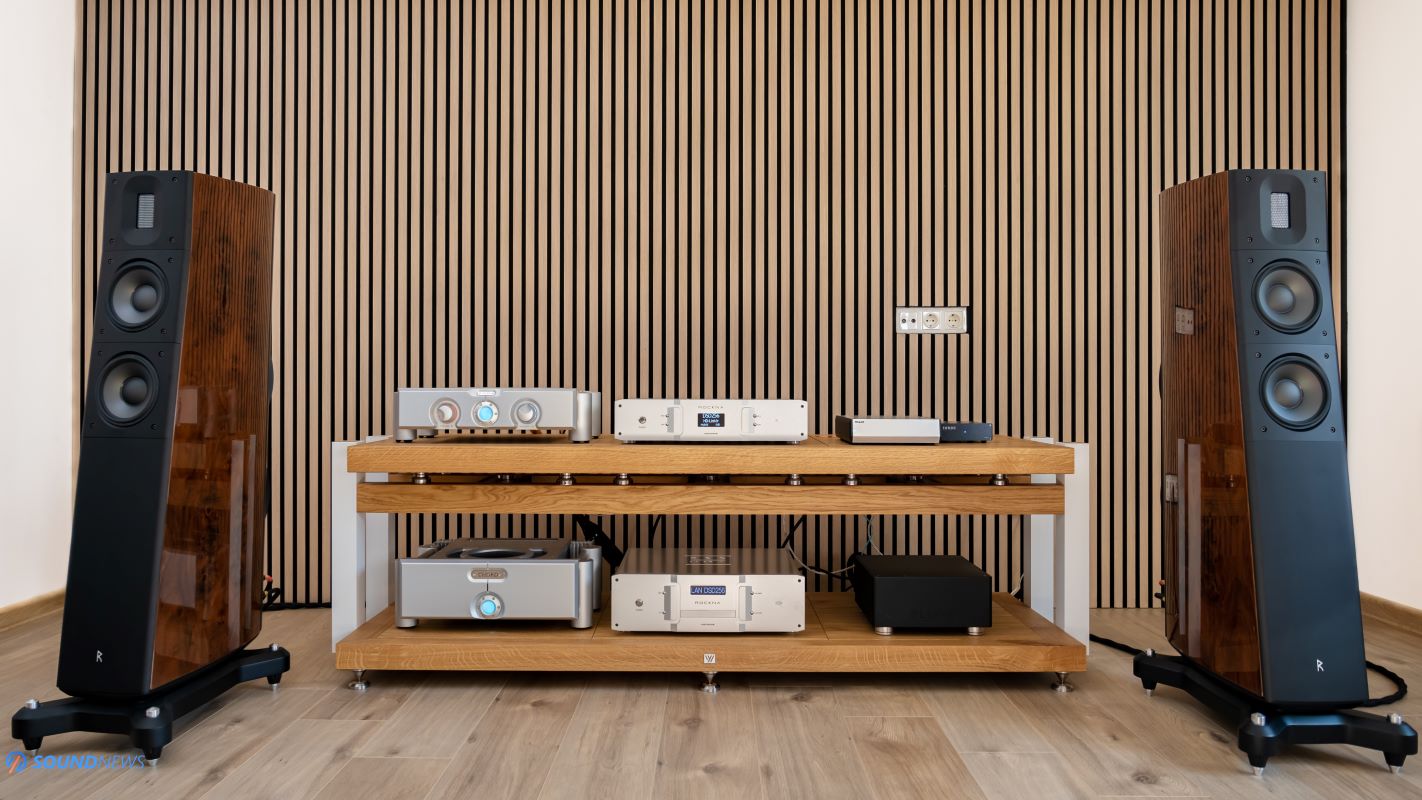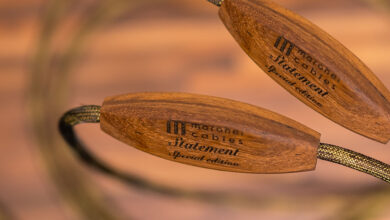The Backbone of my HiFi systems – WoodYard HiFi Racks
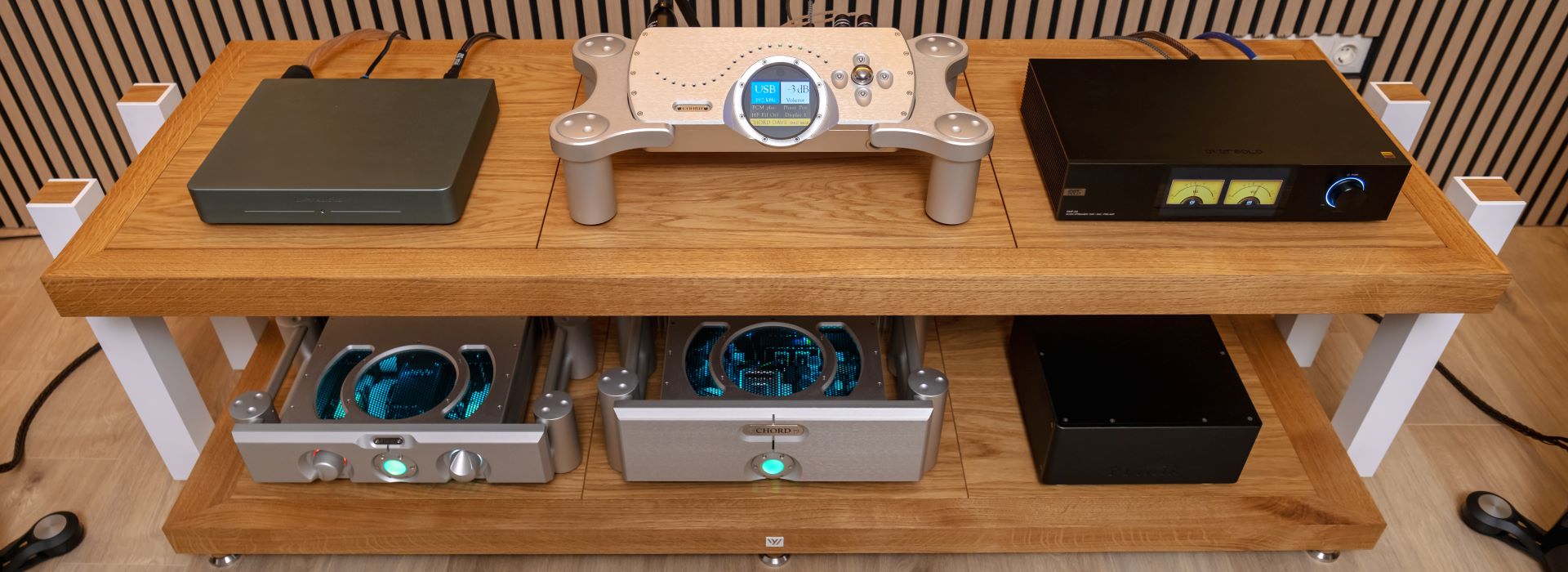
In Chinese cosmology, the universe sprang forth from a primordial chaotic energy, organized into the cyclical dance of Yin and Yang. Yin, often associated with being receptive and passive, contrasts with Yang, the active and expansive force. These dualities, such as light and darkness, fire and water, and the expansion and contraction of the universe, are physical manifestations of the Yin-Yang concept.
If you dig deeper into Taoism, then you’ll soon discover that Yin and Yang are complementary rather than opposing forces, in which the whole is greater than the sum of its parts. This ancient wisdom teaches that everything around us has both Yin and Yang energies, including flora, fauna, and humans. The Yin-Yang symbol embodies this concept, a circle divided into two halves by a sinuous line. One half is typically black, representing the Yin side, while the other is white, signifying Yang. A dot of each color resides near the center of the other’s half, symbolizing the interconnectedness of these energies.
If you have been experimenting with HiFi systems for a while, then you already experienced the Yin and Yang concept. The most active elements sitting inside our HiFi equipment are generating some sort of energy, be it electrical, thermal, or mechanical. Thermal energies are usually suppressed by heat dissipation mechanics. Mechanical (or motion) energies, however, aren’t fully stopped by heavy-duty cases. Thus, some manufacturers are relying on additional vibration control devices that would ideally null vibrations for better overall performance.
The strongest mechanical vibrations originate from the power supply implementations, input and output stages of HiFi equipment. Transistors and vacuum tubes generate micro-vibrations that can negatively impact sound quality, both objectively (as measured) and subjectively (as perceived). While robust cases and isolation feet provide some protection, additional measures are necessary to counteract the vibrations emanating from speakers.
Today, I will tell you a story about my Yin that stopped the Yang forces coming from my amplifiers, preamplifiers, DACs, and streamers, and as you already guessed, today I will be featuring not one, but two gorgeous looking HiFi racks, that I’ve bought with my hard-earned money, build according to my needs and strict specifications. One is fighting a much harder battle against 5 active units sitting in the main stereo room, and a much simpler, but equally beautiful rack is used in my office, that supports a gargantuan head-fi battle station near a wall full of headphones.
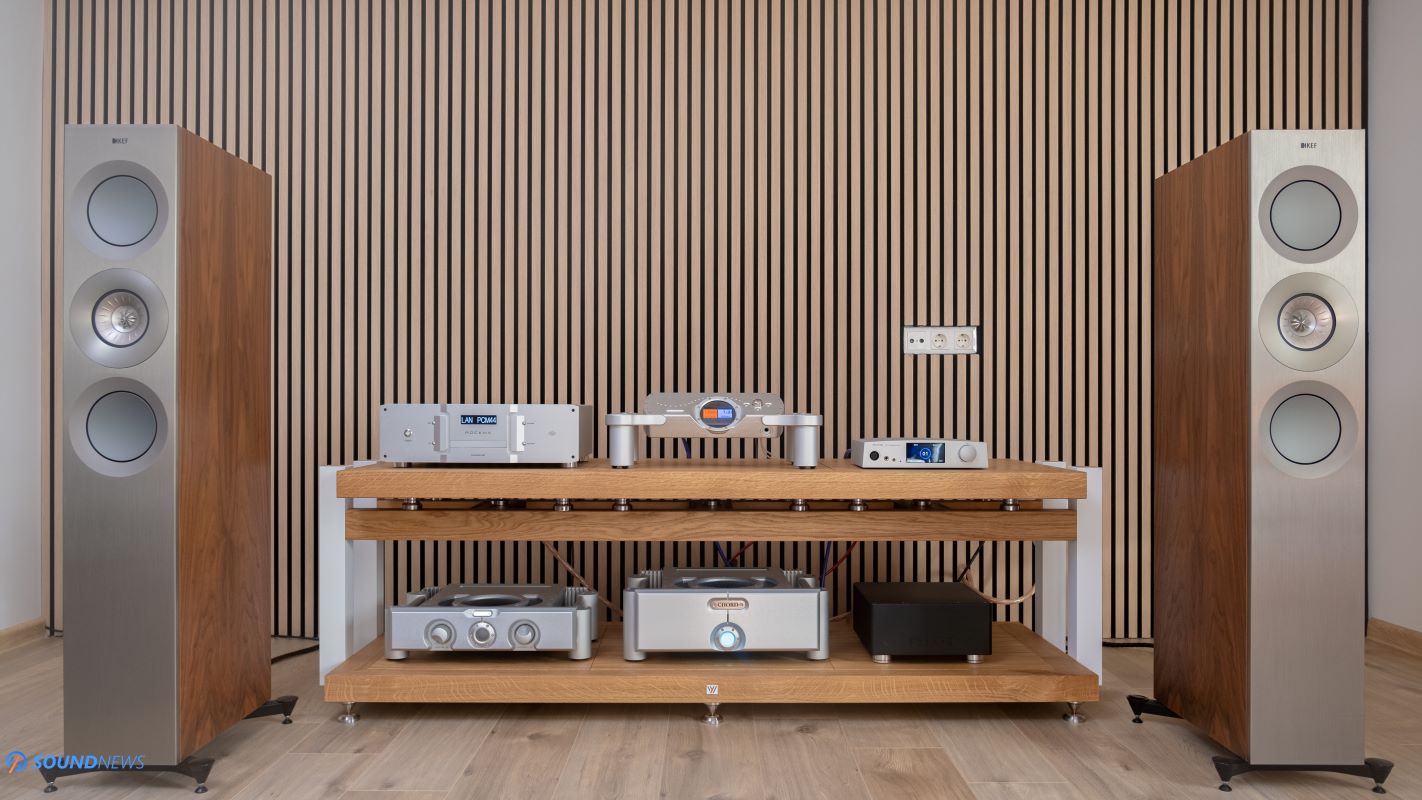
Unveiling WoodYard HiFi Racks
These folks go by the name WoodyYard, and while their main gig is crafting custom and standard-sized HiFi racks, they’re not just one-trick ponies. They dabble in accessories galore – vinyl racks, speaker stands for bookshelf and stand-floor speakers, heavy-duty platforms – with hints of more intriguing stuff to come in the future.
Before you dive into their website, know this: these gents genuinely give a hoot about what they create. I’ve crossed paths with them twice now. First, at the Munich High End Show 2023, where the Rockna Audio room sported their latest Reference rack. Then, in the flesh when the racks were delivered and pieced together by the wizards behind the WoodYard brand. Daniel Schneider and Florin Raicov might seem like your everyday folks, but once you peek into their workspaces where CNC machines, wood carving, and sanding gadgets dance in harmony with Artificial Intelligence that nullify vibrations, you realize these aren’t just your run-of-the-mill HiFi racks – they’re modern furniture art. Both Daniel and Florin are hardcore music lovers and bona fide audiophiles. They flaunt snapshots of their systems, and after witnessing the elegant racks in their HiFi listening lairs, it dawned on me: killer engineering and design skills, merging natural woods, metals, and other unyielding materials (hello, carbon), coupled with an unquenchable thirst for kickass sonics, always results in racks that not only look fabulous but also sprinkle sonic stardust.
They’re groove seekers who tap their feet to tons of tunes and then critically appraise their brainchildren, giving due props to acoustic measurements, aesthetics, and, of course, sound. Now, to unravel the essence of WoodYard and their gear, let’s toss some (tricky) questions at none other than Daniel Schneider, the maestro behind these sonic sculptures.

Q&A Session with Daniel Schneider of WoodYard
Sandu Vitalie (Soundnews) Q1: Can you tell us how it all started, what was the spark that ignited the fire? We’re curious about the story of the brand and why you chose to craft high-end audio racks.
Daniel: It all started when I was looking to purchase a rack to match my living space. Being a wood lover all my life, there were few options that were aesthetically pleasing, so I designed and built one for myself out of solid wood. I quickly learned that solely relying on solid wood wouldn’t suffice in terms of performance. This realization initiated my journey to learn, design, and build Hi-Fi racks incorporating solid wood.
Q2: What are the main product lines?
Daniel: For now, there are four series available:
- The Solid Wood series primarily caters to vintage gear enthusiasts. These racks aren’t solely focused on performance but rely on the thickness of solid wood slabs to provide mass and significant dampening.
- The Classic Modular series features a modular design suitable for medium to heavy equipment. It utilizes a combination of stainless steel, steel, and solid wood, working collaboratively.
- The Suspended series was created to provide a pilon-free area in a side-by-side configuration. Eventually, a single, non-side-by-side version was developed too.
- The Reference line represents our best efforts to create a special rack that embodies exquisite appearance and unparalleled functionality.
Q3: Decoupling systems – what are those and why did you start applying them in your products?
Daniel: Decoupling two surfaces fundamentally means having absolutely no relationship between them. Achieving this level of separation is only plausible using an anti-gravity generator, which, unfortunately, still belongs in the realm of science fiction. The best technology available currently involves magnetic or air levitation, which still maintains a small degree of coupling. Absolute decoupling remains impossible, thus rendering a perfect coupler/decoupler non-existent.
In our racks, we effectively utilize coupling technology alongside decoupling. Both aspects are fundamental to any Hi-Fi rack, regardless of its performance degree. Despite the common belief that a spike system entirely decouples, this is only partially true. Vertically, a spike generally acts as a coupler. However, its behavior on a horizontal plane depends on the surface it sits on, acting as a decoupler on a frictionless hard surface and as a coupler on a soft, easily puncturable surface. The implications for sound quality vary based on implementation.
Q4: Besides cutting and sanding the wood, what additional techniques and technologies are used when crafting your audio racks?
Daniel: In addition to classic wood cutting, planning, and sanding tools, we utilize an arsenal of CNC machines. Depending on the application and part, we employ CNC routers, waterjet, laser and plasma cutters, CNC turning, milling, and machining centers. We extensively use presses for combining materials requiring gluing, while wood finishing is always done by hand.
Q5: How do you decide which materials you’ll need when making a rack?
Daniel: As our focus is on integrating the warmth of wood into people’s living spaces, our material selection revolves around solid woods with suitable density and excellent dampening properties. Depending on the implementation and purpose of the part in question, we use various materials such as aluminum of different grades, stainless steel, steel, and composite wood. Our material selection primarily aims to eliminate surfaces that resonate, meaning a pine wood rack will never be offered by us.
Q6: Can you measure any difference between various technologies, in vibration control or in audio reproduction?
Daniel: Absolutely. A well-calibrated, high-resolution sound system will showcase varying results with different rack technologies. Similar to other components, certain systems benefit more or less from specific rack technologies.
Q7: How exactly did you use Artificial Intelligence (AI) in the modeling process and why?
Daniel: We’ve recently incorporated Autodesk’s Generative Design Extension for Fusion 360 in our Suspended series, specifically for shaping the upper shelves. This software allows us to set manufacturing requirements, loads, and constraints, generating designs that are practical and efficient. We plan to further enhance our lineup using this technology in the future.
Q8: Do you think innovations and breakthroughs could still happen in this field in the following years?
Daniel: I firmly believe that major innovations will emerge in both manufacturing processes and performance. Smarter utilization of materials will lead to increased performance per dollar spent.
Q9: What is the most defining thing about your products and why people should invest in WoodYard?
Daniel: Embracing the unwavering commitment to incorporating solid wood in our designs truly defines WoodYard. Our determination lies in innovating and providing high-tech racks that exude warmth and approachability, distinct from the cold, industrial look often associated with a gym or dungeon-like aesthetics. The stubbornness in sticking to solid wood signifies our dedication to preserving the natural charm and inviting ambiance that only wood can offer. Our vision is to harmonize cutting-edge technology with the timeless appeal of wood, creating sophisticated, high-performance racks that seamlessly blend into diverse living spaces.
End words: Thank you for accepting our Q&A session and for building centerpieces of high-end audio systems, disguised as pieces of modern furniture.

WoodYard Suspended Range
The Suspended range was designed to seamlessly integrate into any interior, whether modern or classic. My particular rack is called Suspended Triple since it utilizes three shelves per floor and belongs to their premium collection. According to their creators, this is a true anti-vibration and resonance-free masterpiece disguised as a warm piece of furniture.
This model has undergone numerous prototypes and countless measurements to achieve its current form. It’s a truly exceptional rack. Obtaining the rigidity and anti-resonance properties required at this length while maintaining an open interior and eliminating pillars was quite a challenge.
Using AI generative design and modal analysis, they were able to create a shape for the upper section with a very low resonance point. Crafted from multi-layer pressed hardwood, dampened by an aluminum sheet, and wrapped in a 50mm x 61mm thick solid wood frame. Testing has been conducted using a modal impact hammer and a 3-axis accelerometer system.
The upper section is attached to the main structural beams below using 15 stainless steel/ceramic bead coupling elements while maintaining minimal contact in the lateral legs using lateral stainless-steel spikes. The entire upper section acts as one ultra-rigid and inert unit, and I can personally attest to that. If you knock on any part of the structure, you’ll hear an extremely short thud, effectively neutralizing any mechanical vibrations. The three multi-layer natural veneered shelves rest hidden atop this structure using a brass and steel spike system.
The upper section was designed for ultimate resonance control, making it ideal for extremely sensitive equipment such as turntables, tube-based HiFi equipment, CD players, DACs, and digital transports.
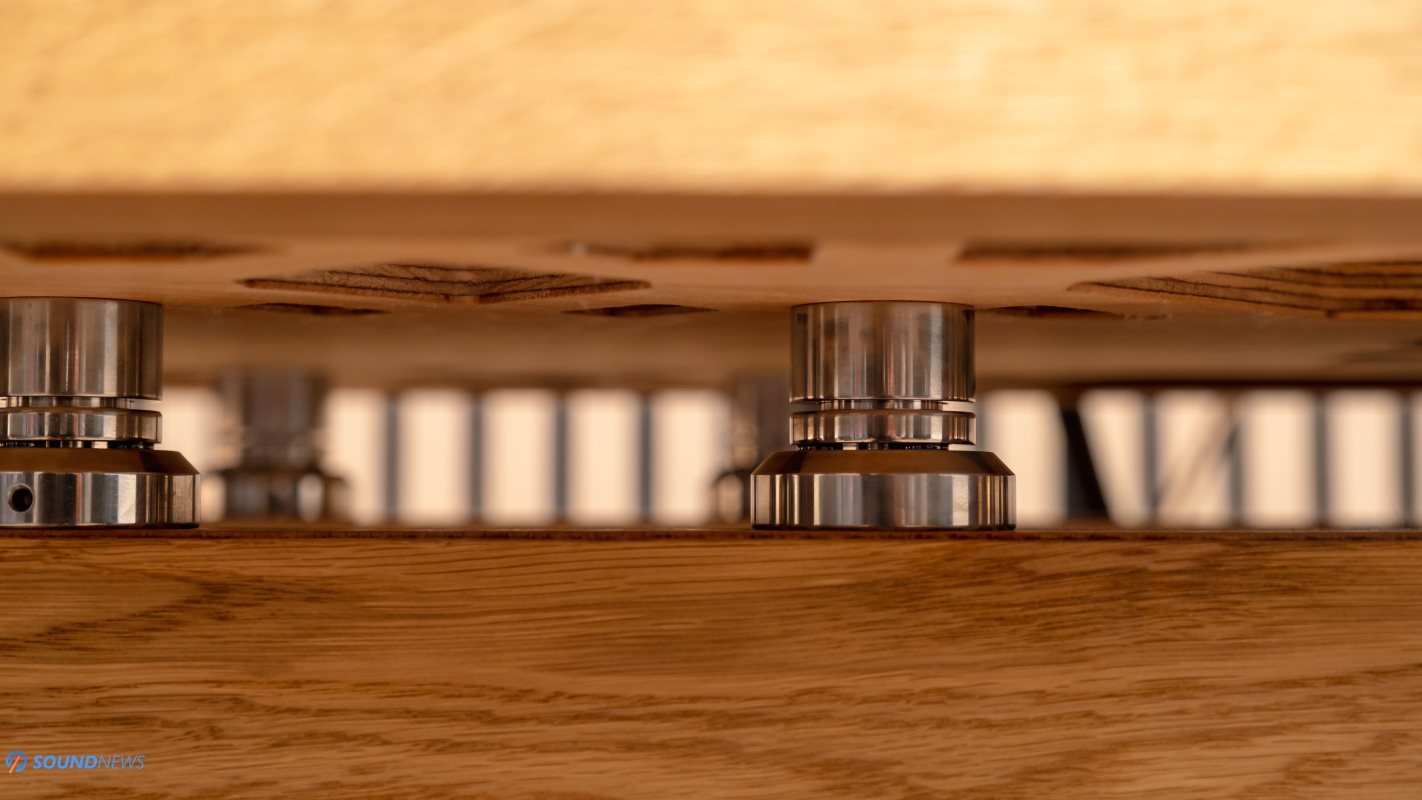
The bottom section consists of multiple-density materials compressed together and framed by a thick solid wood frame. The three shelves on the bottom are completely separate, that’s right! They’re not connected to each other, but they’re not removable either. The rack sits on either ceramic bead decouplers or 50mm diameter stainless spikes, but for maximum vibration control, we recommend opting for ceramic bead decouplers.
The model is available in Oak, Ash, Wenge, and Black Walnut solid woods. I chose oak for several reasons: it’s the lightest-looking option, and I’ve always been inspired by the many great poems written under oak trees. I always find inspiration when I gaze upon the oak rack with white legs.
Each of the two structural beams is crafted using two 11-layer plywood sheets sandwiched with a solid wenge sheet in between (see the photo for clarification). What sets this construction apart is the unique orientation of the wood fibers: the plywood layers have fibers aligned along the Y and Z axes, while the wenge wood layer features horizontal fibers along the X axis. This innovative technique significantly reinforces the structural integrity of the beam, allowing for a relatively thin profile (albeit at 70mm) that resists bending and minimizes resonance. Additionally, this design minimizes tension resonance, contributing to an optimized performance. Wenge is an African wood with a natural black appearance, has a higher density than usual, and is extremely rigid. The bottom shelves can support a total of 200kg of equipment, while the upper shelves can handle a total of 95kg.
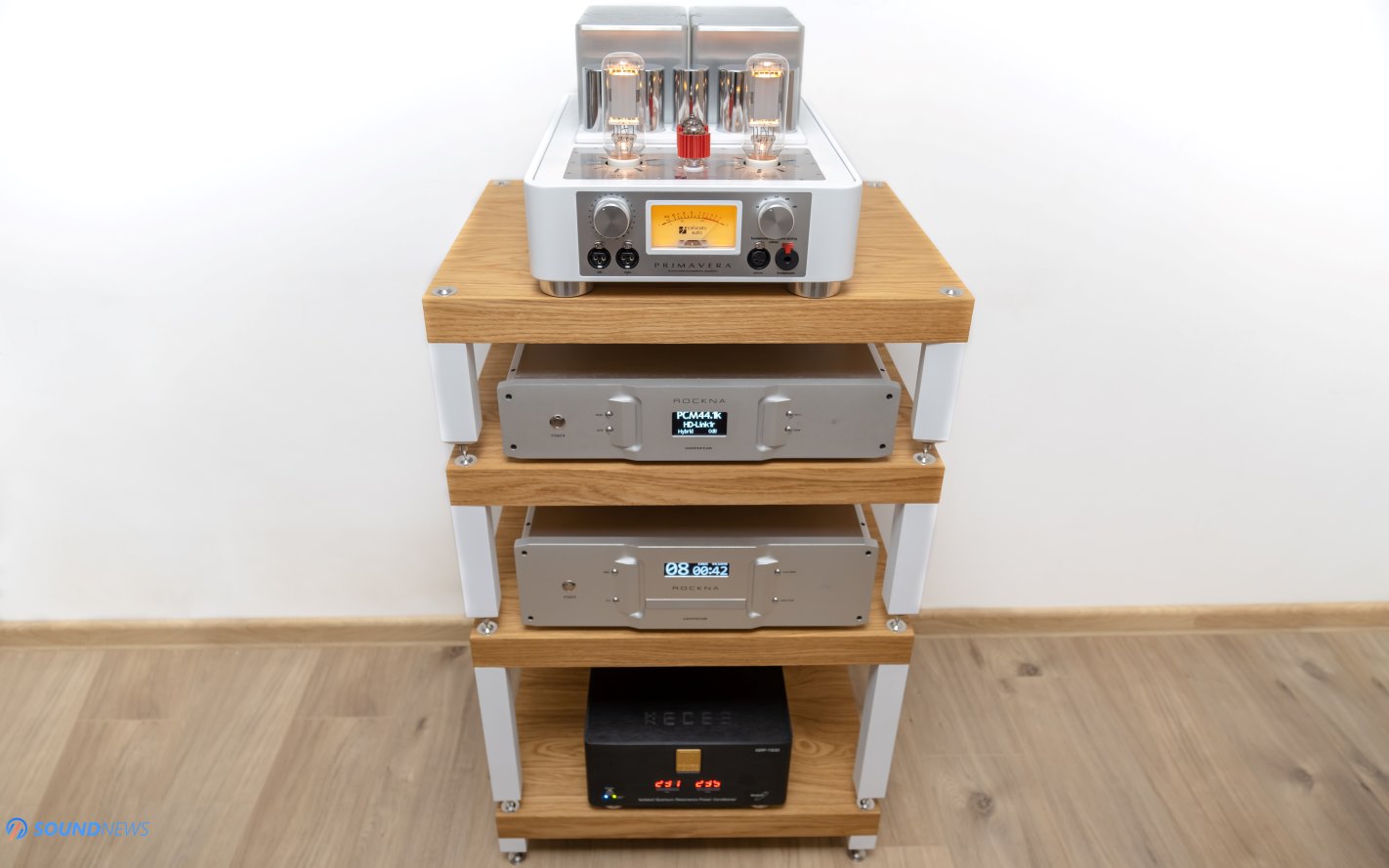
WoodYard Baby Modular Range
The Suspended line is designed for high-end audio applications, where vibration control is paramount. However, if it might exceed your budget, then WoodYard is here to rescue the day with their entry-level Baby Modular range. It features 50mm thick shelves crafted from HDF, beech, and birch plywood. The plywood construction showcases alternating fiber patterns. The shelves are adorned with natural wood veneer, and the legs are also crafted from wood composite, available in either satin white or black.
Each shelf securely interlocks with the next, utilizing a stainless-steel spike system. In terms of performance, the rack relies primarily on its mass, multilayer shelves, and spike system. The bottom shelf can support up to 60 kg, while the upper shelves can handle up to 35 kg. It’s termed ‘modular’ because you can add up to 5 shelves in total, and despite being significantly more affordable than their previous models, it’s exceptionally rigid and has a rock-solid foundation, capable of supporting heavy equipment without breaking a sweat. I’m using a 30kg Trafomatic Primavera tube-based headphone amplifier on the upper shelf, and it doesn’t budge even when I push it with all my might.
My office desk was teeming with electronics, and I’ve always desired a dedicated audio rack for my headphone listening station. Since I didn’t want to break the bank, I opted for WoodYard’s Baby Modular rack, which by the way is 100% customizable to your specific requirements. If you have hulking amplifiers or tall tube-based amps, you can always add shorter or longer legs, and deeper or wider shelves to accommodate your gear.
Test Equipment
The Suspended Triple rack was put through its paces in the main system, which consists of the EverSolo DMP-A8 Streamer & Roon endpoint, Chord Electronics DAVE DAC, Chord Ultima 3 preamplifier, and Chord Ultima 5 power amplifier. All of this gear draws power from a Plixir Elite BAC1500 balanced passive power conditioner. The Baby Modular rack was put to the test in the head-fi system, which consists of a Rockna Wavedream NET Roon server, CD player, and music server (powered by the internal 4TB SSD drive), Rockna Wavedream Signature XLR DAC, and Trafomatic Primavera. The whole system is powered by the KECES IQPR1500 balanced passive power conditioner.
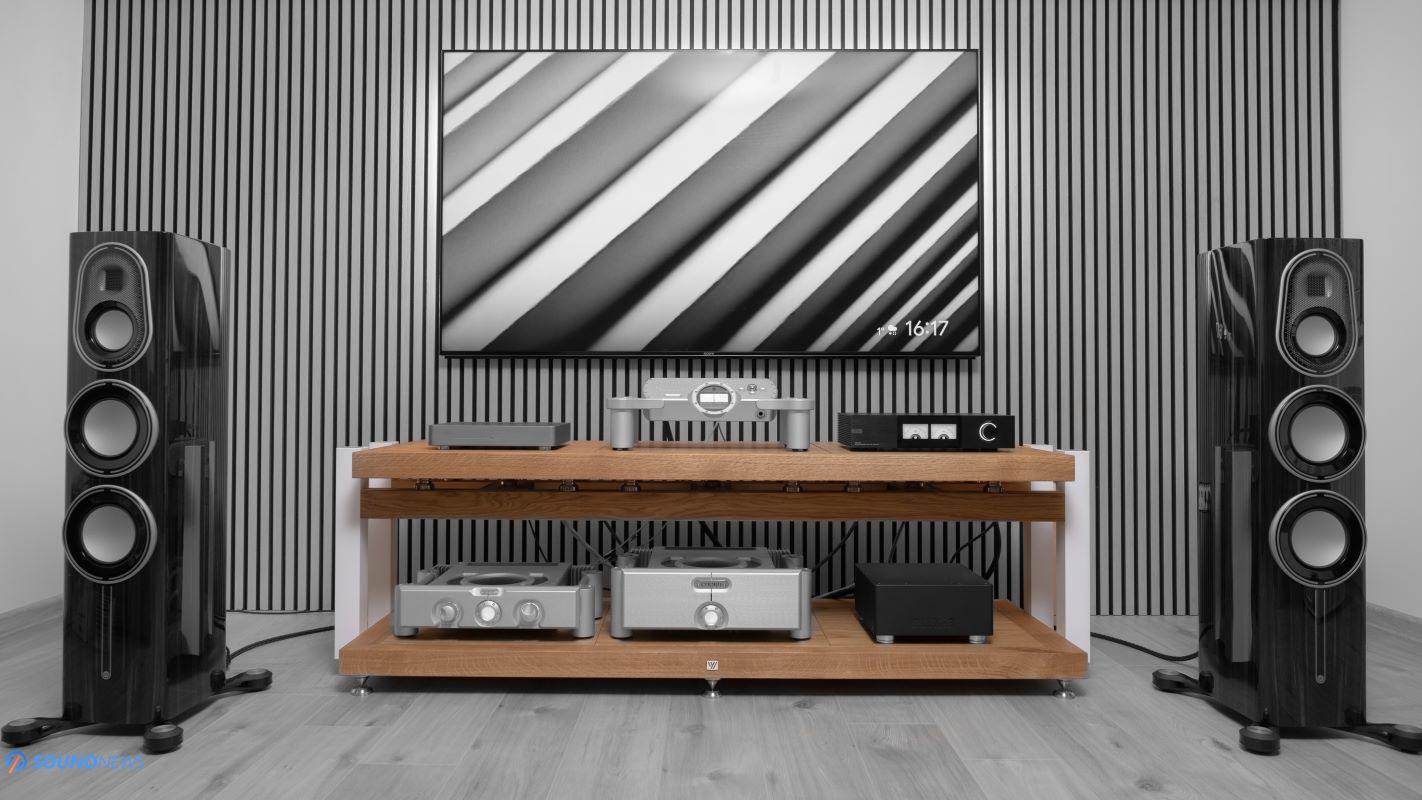
How I ended up getting two WoodYard Racks
Let’s rewind the story and recall the reason why I chose WoodYard in the first place. My closest friend Catalin, our newest writer around here, purchased a Baby Modular rack last year to be used in his head-fi battle station. He also utilizes a Chord DAVE, Chord M Scaler powered by a linear power supply, the formidable Trafomatic Primavera, a Melco streamer, and an Audioquest Niagara 1200 power conditioner. It’s a system that’s carefully thought out, and designed to arouse emotions while never compromising the technical prowess of the DAVE. It’s an incredibly natural-sounding system that needed a suitable rack to support its weight.
I visited Catalin over the weekend to listen to some tunes and was struck by how clean and, dare I say, lovely the Baby Modular rack looked. The construction was outstanding, and he later admitted that the headphone system sounded slightly clearer than before. I knew I needed one for myself.
I liked the tidy appearance of the rack. It had a modern vibe to it, with the Primavera’s orange glow adding just a touch of warmth to the top shelf. A modular rack like this would be a significant space-saver in my office, and if the head-fi system sounded better, that would be the icing on the cake.
However, the biggest problem was the living room and the equipment that I had begun piling on top of each other. The KEF Reference 3 are currently being replaced by a pair of Raidho TD2.2 speakers. While I’ve always appreciated the sound of the KEFs, especially when combined with a touch of liquidity and warmth to create a perfect system match, the low end was far too strong for my 25m² listening room. I didn’t need to turn the volume up to 85 or 90 dB SPL; even at around ~75 dB SPL (measured using MiniDSP microphones), the walls of the living room were trembling with fear. The entire structure of the building was dancing to the rhythm of the music, and I never enjoyed that aspect. When I acquired flagship-grade active bass traps from Artnovion, the bass went from muddy to clean and defined in a jiffy. Its resolution improved, its vibration was partially controlled, and I could finally raise the volume if I desired…but it still wasn’t the refined bass I’m accustomed to hearing in well-treated HiFi rooms.
With an IKEA TV stand supporting a streamer, DAC, and two smaller power amplifiers (Benchmark AHB2) to support it, I always felt like the stereo image was blurry, with plenty of information to the sides near the corners of the room but not enough in the middle. That’s the primary reason why most of my older articles and videos featured an extreme toe-in of the KEF Reference 3, as I wanted to hear the voices emanating from the middle of the room.
I conducted a few measurements in the living room and discovered a clear drop in midrange energy for reasons unknown to me. I always suspected that the IKEA TV stand, with the TV sitting on top of it, was doing more harm than good. Instead of suppressing the vibrations emanating from the speakers, they were amplifying them, resulting in a fuzzier stereo image and a weaker midrange presence. The thick wall behind my speakers also proved to be a problem. It’s constructed of a thin layer of concrete with an extra layer of BCA insulation, which amplifies the vibrations in the room and adds a longer echo to everything. I faced two major issues that needed to be addressed immediately, regardless of how good or bad the electronics were; the strong reverberation of the room had to be addressed first.
Long before the back wall was covered with acoustic panels, which nicely diffuse the sounds across the room (here are the ones I used in case you’re curious), I wanted to tackle the TV stand problem first. I was drawn to the Suspended Triple with its cutting-edge decoupling, vibration control, and stylish design, and I ordered a custom rack, which arrived about two months later. After carefully explaining to Daniel and Florin where it would be placed, what its primary purpose would be, what equipment I would be using with it, and the dimensions of my gear, they showed up at my doorstep on a Saturday. I helped them carry everything into the apartment, which was quite a challenge, as the entire structure weighs around 110 kilograms (242 pounds). After meticulously assembling it like a LEGO set, Daniel and Florin rushed back home for a 600-kilometer drive to spend the remaining weekend with their families. I, on the other hand, after sipping from a morning coffee and wiring everything up, embarked on an extended listening session with my family.
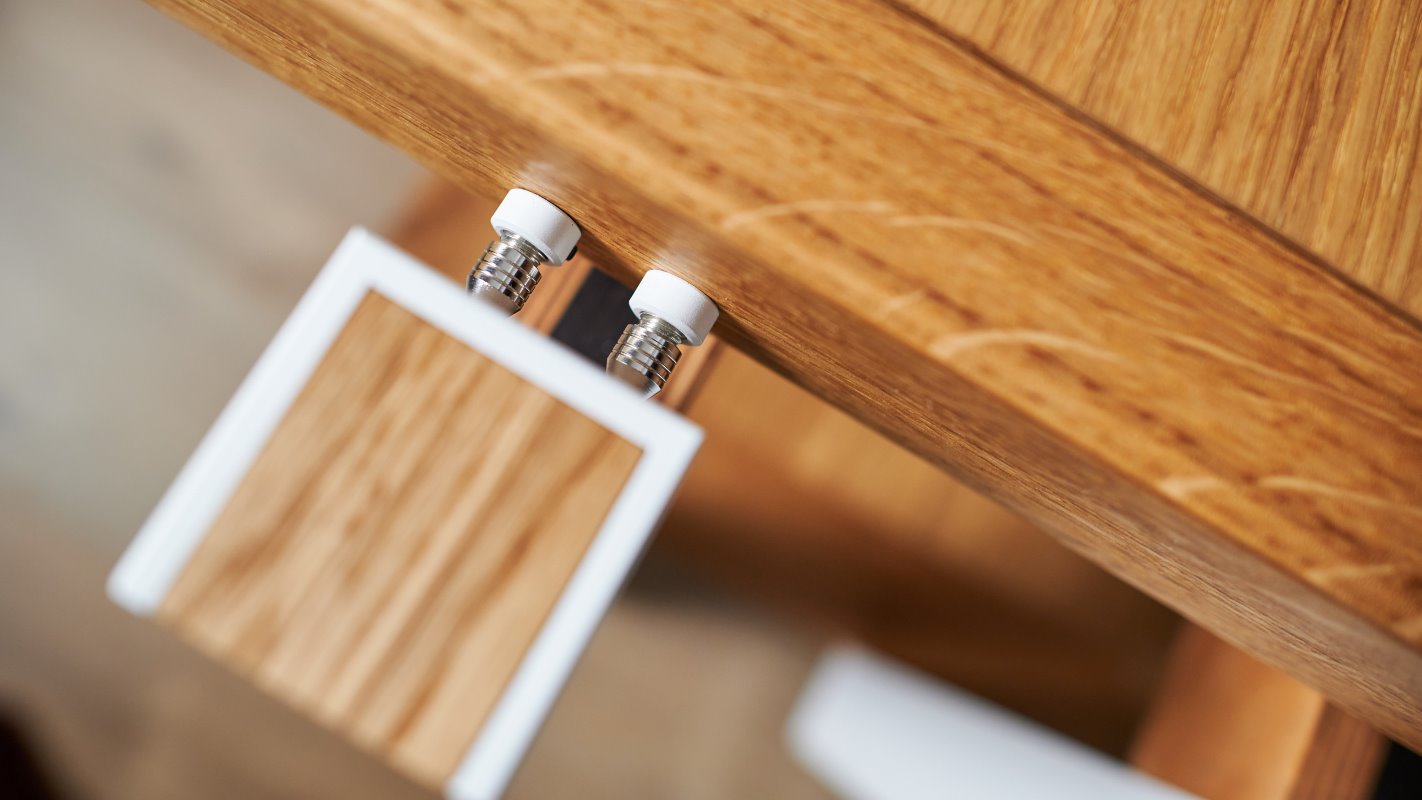
Sound Impressions
I. WoodYard Suspended Triple
Before delving into the specifics, it’s worth noting that the electronics resting on the rack are, to all intents and purposes, the epitome of high-fidelity audio. I’ve assembled a system so discerning that even the slightest alterations, such as a new interconnect cable, power cable, or power strip, can be easily perceived. If the rack has any influence on the sound, it will unquestionably be evident.
When you think about it, loudspeakers, regardless of their size, constantly bombard the room with physical energy via the floor, even if it’s a suspended wooden floor or a concrete slab. They also bombard the room with sound waves that reach every corner of the room, including the HiFi equipment. No matter from what angle you’re looking at, the speakers produce the biggest assault on the room and on the electronics themselves. All of this, combined with the tiny vibrations generated by the HiFi components themselves, can significantly degrade the sound quality.
If you want to get amazing results in a stereo setup, much like extremely important room acoustics, you need to have the essentials, and a good audio rack is quintessential. Every element part of the Suspended range was designed to attenuate or (ideally) null the energy emanating from HiFi components and speakers. To further minimize vibrations and reduce resonance as much as possible, ceramic bead decouplers are also included beneath the structure and the top shelves.

After calming my spirits, I embarked on a lengthy listening session and after trying a wide variety of musical genres, I can safely say that a well-designed audio rack makes a significant difference. While I lacked the necessary equipment to provide objective measurements, the subjective difference was immediate and I didn’t need a couple of minutes to witness the sound improving, getting more spacious and considerably more focused, especially in the middle of the room. The nulling effect I had in the middle of the room was no longer apparent and I could use a less pronounced toe-in of the speakers, widening the soundstage in the process.
The bass went from great to outstanding, the walls were no longer dancing when I was cracking the volume up and the difference was so immediate, that I felt the Artnovion Acoustics bass-traps were no longer necessary behind the bass-reflex ports of my speakers, piling them on top of each other in the right corner of the room. The midrange region also received a significant boost, getting denser, clearer, and more present all around. The tiniest intricacies of the human voice were finally reaching my eardrums, and the smallest details were being brought to the fore, appearing well-defined and focused.
Being my firsthand experience with a proper-made rack, I didn’t know what to expect. I regret that Daniel and Florin didn’t stay for a second day to witness the tightened sound, enhanced resolution, and remarkable midrange improvement, I’m sure they were aware of the rack’s potential, but I was truly impressed.
A few days later, some of my closest friends stopped by. They were impressed with the rack’s stiffness, build quality, and aesthetics, but they also remarked on the tighter, more controlled sound, which eliminated the unwanted reverberations that had previously shaken the foundation of the room.
The difference was so noticeable that comparing the sound with and without the rack seemed pointless. It was like adding a high-quality streamer to your DAC for the first time, bypassing the need for a USB connection from a PC, and replacing a low-end amplifier with a much better one with greater power reserves.
Instead of listening for an hour and then cycling for a few hours over rough terrain with my son as I had originally planned, I stood there for the rest of the day, listening to a couple of albums, experimenting with different musical genres, and reaffirming my belief in the benefits a well-designed audio rack can bring to a high-quality stereo system.
Despite using the same gear, speakers, and ears, the sound underwent a significant transformation, as if not one, but several components had been upgraded to a higher grade. The final result was a tighter, less smeared sound, which was to be expected, but I was surprised by the clarity, layering, and richness of the bass, as well as a sweeter midrange performance, which I never could have anticipated.
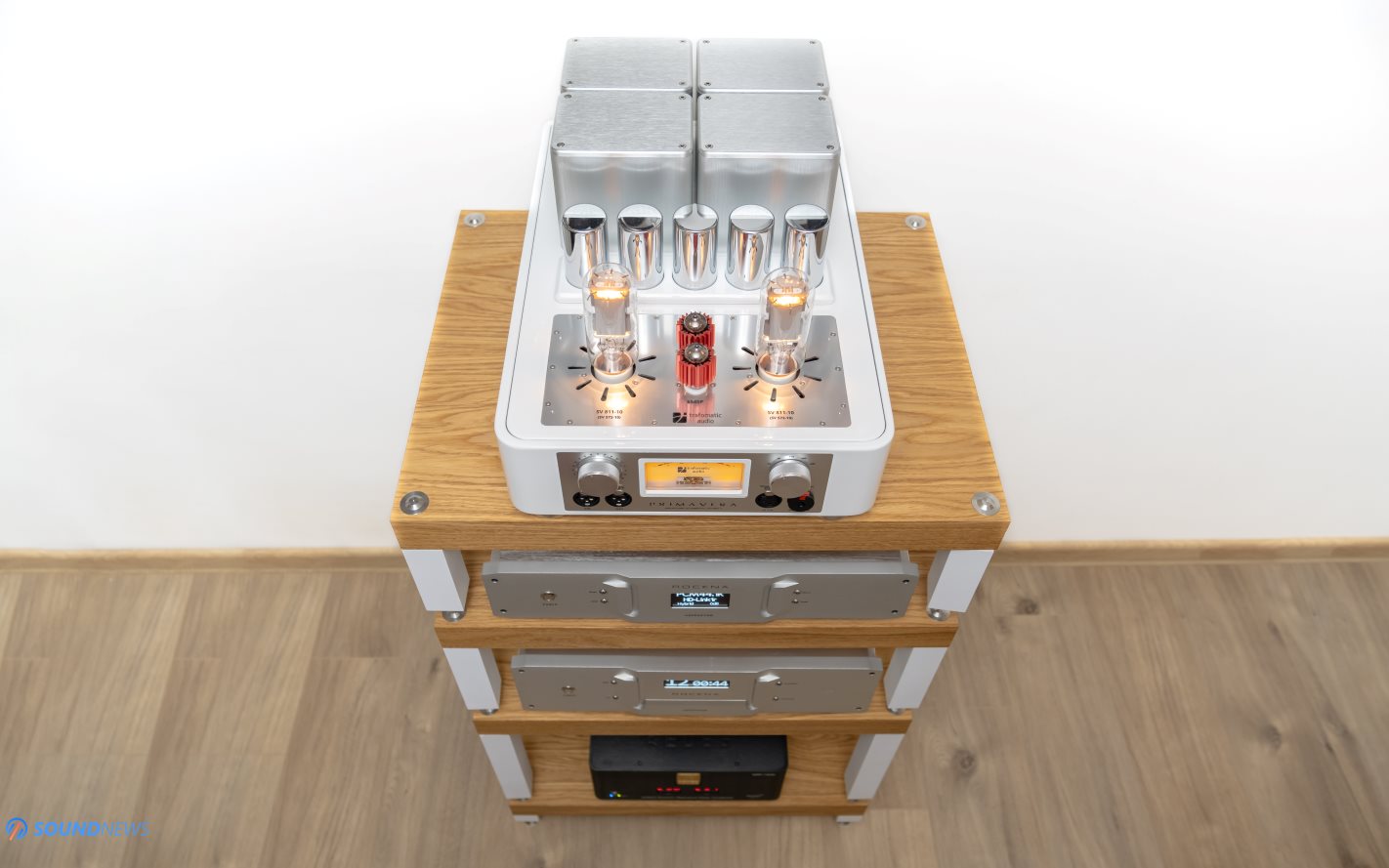
II. WoodYard Baby Modular
The Baby Modular rack isn’t as cutting-edge and doesn’t use as many decoupling techniques, plus the shelves themselves aren’t as advanced as those from the Suspended range. I assumed that it wouldn’t have an impact on the sound, as it would be used in my office, holding a head-fi setup that is not pounding the room with sonic energy.
Baby Modular did exactly what it needed to do: it was able to sustain four ginormous devices, including a very heavy one on top. When pushing the rack with my thumbs, you can feel its weight and stiffness, having a solid foundation.
The subjective performance wasn’t as dramatic and the differences were minor at best, or nonexistent at worst. The only thing I can say is that the sound got a hair tighter and faster sounding. When I added the EAT tube dampeners to the driver tubes of the Trafomatic Primavera, I felt a very slight improvement in the tightness of the sound as the driver tubes were no longer vibrating, getting a nicer control over headphone drivers. The baby Modular rack further improved the tightness of the sound and as a bonus, it marginally improved the transient response. The headphone setup as a whole felt a bit snappier, with the shifts from low to high dynamics happening instantaneously. Subjectively speaking, I feel there is a minor improvement if you’re using extra sensitive gear on it, such as a turntable, a tube amplifier, or a streamer plus DAC.
At the end of the day, it’s an affordable rack that feels overqualified for the job. It saved me a lot of desktop space, it still looked great and further tightened the sound. Considering how heavy the Rockna Wavedream stack is, together with the power conditioner and Trafomatic Primavera on top, I’m pretty sure it will work as well in a proper stereo rig. If you can’t afford a rack from the Suspended or Reference range, then any of their Modular series should do justice to your setup.

Wrapping Up
Bidding farewell to the IKEA TV bench was the best decision I made this year, along with adding two active bass traps and acoustic panels behind my speakers. Surprisingly few people know this, but I have been slightly disappointed with the performance of the KEF Reference speakers over the years. It turns out that the issues I was encountering were not entirely their fault.
After two years of trial and error, swapping out a significant portion of my electronics and then adding the finishing touches in the form of acoustic treatments and a HiFi rack, the speakers finally revealed their true beauty. I believe I was able to extract the best performance out of them.
Now, here’s the kicker: after swapping every single component this year, adding a rack, bass traps, and acoustic panels, I felt that the Reference 3 had reached their full potential. They had reached their ultimate destination, and since I was still on my audio journey, it was decided that a pair of Raidho TD2.2 speakers would replace them in January 2024. I’m eager to see how they fare, as I believe they have the potential to elevate my system from good to great.
WoodYard HiFi racks are not only aesthetically pleasing, combining modern technology with the beauty of solid wood, but they also help you get the most out of your precious equipment. As their name suggests, these folks use several types of hardwoods in their Suspended and Reference lines, which tend to eliminate the harshness and hardness of the sound. They aim to achieve a tighter and fuller-bodied presentation, while also adding sweetness and tranquility. The outcome was a clearer sound and a sharper stereo image, with excess resonance reduced for a smoother listening experience.
I can’t say for sure what improvements any of their racks, isolation systems, and accessories would bring to your system, but if you’re using sensitive equipment such as tube amplifiers & preamplifiers, turntables, DACs, and streamers, then you should definitely celebrate with champagne before booting up your system on a brand-new rack.
If you compare the pricing of similarly made custom racks, speaker platforms, stands, and accessories worldwide that use similar technologies, then you’ll soon realize that WoodYard isn’t charging astronomical prices. They’re among the most affordable options you’ll find in Europe, which is why I chose them at the end of the day.
They are currently shipping across Europe, and you can check out their portfolio right here. If you’re interested in anything they offer, here’s the contact form. If you’re getting one of their racks, please let me know in the comments section below, and don’t forget to smash that subscribe button over YouTube. Until next time, folks!
ASSOCIATED EQUIPMENT:
- HiFi Racks: Woodyard Suspended Triple & Baby Modular
- DACs: Rockna Wavedream Signature XLR, Chord Electronics DAVE, Note DS-10 Plus
- Wireless Streamer & Music Server: EverSolo DMP-A8, DMP-A6, Rockna Wavedream NET
- Roon Core: Rockna Wavedream NET
- Headphone Amps: Trafomatic Primavera, Enleum AMP-23R, Ferrum OOR + HYPSOS, Burson Soloist 3X GT, Flux Lab Acoustics Volot
- Preamps: Chord Electronics Ultima 3 Pre
- Power Amps: Chord Electronics Ultima 5, Burson Timekeeper 3X GT (x2)
- Loudspeakers: KEF Reference 3, Raidho TD 2.2 (incoming)
- Full-sized headphones: HiFiMan Susvara, Audivina, Ananda Nano, Erzetich Charybdis & Phobos V.2021, Meze Elite & 109 PRO, Sennheiser HD800S, Kennerton Rognir & Vali, Apos Caspian, Sendy Peacock & Apollo, HarmonicDyne Poseidon & others
- Interconnects: Crystal Cable Reference2 Diamond, QED Reference (x2), Topping TCX1 (x2)
- USB Cables: Supra USB Excalibur (x2), Chord C-USB, Matrix Hi-Fi USB
- HDMI Cables: AudioQuest Diamond
- Speaker cables: Kimber PR8, Audioquest Type4
- Power Cables: Isotek EVO3 Premier (x3), iFi Audio SupaNova (x3)
- Balanced Isolation Power Conditioners: PLiXiR Elite BAC1500 (stereo setup), KECES IQPR 1500 (headphone setup)
